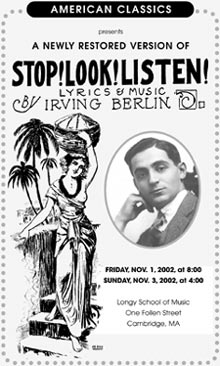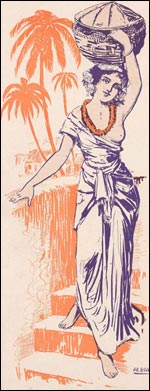 |
 |
| A donation will help the work of American Classics |
|
American Classics - Stop! Look! Listen!
Please click here to listen to selections from the show. "The American Classics crew was exhilarating." - Richard Dyer, Boston Globe In 1914 Irving Berlin had a success with his first complete Broadway score, Watch Your Step, which led to a follow-up in 1915, Stop! Look! Listen! As was true of musicals at the time, the book - once again by the prolific but rarely inspired Harry B. Smith - was simply a frame on which to hang songs. Berlin created a score which built on Watch Your Step and is considered stronger by many critics. His dream of writing a ragtime opera came closest to fruition with the finale of Act II, the "Ragtime Melodrama" (see photo), which takes the dramatic format of the Opera Parody of Watch Your Step and develops it further; popular music, Gilbert & Sullivan, and grand opera all find their way into the music of this scena. Throughout the score, too, are references to songs from Watch Your Step and to other Berlin hits, such as "This is the Life" (1914) and "Araby" (1915). From the outset of the development of the show (originally to be called Blow Your Horn), the plot dealt with a chorus girl's efforts to become a star. The plot also allowed for the development of a variety of other characters and situations. "The Girl on the Magazine" (see photo) was one of those tuneful adventures that dealt with one of the star's many suitors. Originally, it was decided to build the show around the French star, Gaby Delys, her rôle as the chorus girl was expanded, and her name changed from Violette to Gaby. However, during the New York run it became clear that Delys would not be able to carry the show, and her rôle was reduced, until (according to all sources) she had only one song, "Everything in America is Ragtime." Not surprisingly, this caused her to lose interest in the show. The resulting lackluster performances, even in a reduced rôle, hurt the show, and it closed after a fairly short run. Required novelty was provided by two teams, dancers Harland Dixon & James Doyle as Ayers and Steele, and the female duo Florence Tempest and Marion Sunshine as Willie and Vera. Stop! Look! Listen! was successful enough that it went to London, where it was retitled Follow the Crowd. As was customary at the time, songs were rewritten to accommodate the local audiences. In presenting a show from this era, there is always the question of authenticity - do producers slavishly try to recreate an opening night script and score, or take the pragmatic route and put together a performing version which best represents the intentions of the writers? In an odd way, pragmatism is authentic, since producers and writers of the time were always tinkering with shows, often rewriting both script and score as casts changed. We took a more pragmatic route. Three versions of the script are extant, but none of them are the opening night script, so inevitable adjustments had to be made. One character, Anthony St. Anthony ("a leading man") is listed in the opening night program, but has only one short - and rather confusing - scene in the extant versions of the script; in some versions the same scene is played by Hornblower. For this production the character of St. Anthony was dropped and the scene given to Hornblower (who was Abel Conner when the show opened, but the earlier name keeps the pun).
Also, because of adjustments in the script, in the American Classics performances certain songs were reassigned to different characters. In some of the 1915 productions St. Anthony sang "I Love to Dance" with Gaby; for our production Gaby sang it with Hornblower. Hornblower sang "I Love a Piano," for no apparent reason other than to give star Harry Fox a song; for our production we had the song sung by the three characters involved in the scene. St. Anthony also sang "I'll Be Coming Home With a Skate On," a song which has no logical place in any of the extant scripts, so the decision to replace it with "In Beautiful Honolulu" was an easy one. The song "In Beautiful Honolulu" was written for an extended scene that took place in Hawaii in order to take advantage of the Hawaiin craze taking place in the United States at that time. In an odd twist of fate in keeping with the silliness of musical theatre conventions, the script requires the entire cast to board a boat that takes them to Hawaii (see photos). For the scene when they arrive, a Hawaiian Specialty was inserted in the show. In 1915 the Speciality was accompanied by the newly written song "On the Beach at Waikiki" (music by Henry Kailimai and lyrics by G.H. Stover), but for our production, we decided to honor the "spirit" of the original and use the more easily recognized and recent song "My Little Grass Shack" (1933, music and lyrics by Bill Cogswell, Tommy Harrison and Johnny Noble). Cast recordings, as thought of today, did not exist in the United States essentially until the advent of the long playing record. However, in London casts often assembled to record fairly complete scores on 78s, and quite a bit of Stop! Look! Listen! was recorded in 1916 by the London cast and recently reissued by Pearl on The Ultimate Irving Berlin, Volume I (GEM0116). A London studio cast recorded a medley around the same time, which is available on Volume III of the Pearl Broadway Through the Gramophone series (GEMS0084). The show's two big hits, "I Love a Piano" and "The Girl on the Magazine" have had countless recordings, and Berlin re-used them in films, particularly Easter Parade. Sears & Conner also have recorded those two songs, along with "Until I Fell in Love With You," "When I Get Back to the USA," and the title songs for their CDs Come On And Hear! (ORCD0003) and Keep On Smiling (ORCD0007). – Benjamin Sears "[American Classics] outdo themselves with a historical performance you won't see anywhere else." - Beverly Creasey, Theatre Mirror Hear Selections from Stop! Look! Listen!
|
© American Classics • 70 Allston St., Boston, MA 02134, 617-254-1125 • AC@benandbrad.com |
 Stop! Look! Listen! was a critically acclaimed concert musical production presented by American Classics in 2002.
Stop! Look! Listen! was a critically acclaimed concert musical production presented by American Classics in 2002. Two songs which were dropped during tryout were restored: "Until I Fell in Love With You" and the "Sailor Song" (both of which Berlin published, however). Additionally, in one instance, this production has two versions of the same song, "When I Get Back to the USA Ragtime." In the American script it is the end of the "Finale Ultimo;" in the London version it was rewritten as "England Every Time for Me." When the show went to London, new lyrics (it is unclear if they were by Berlin or an English lyricist) were written for "I'll Be Coming Home With a Skate On," turning it into "In Beautiful Honolulu", with an appropriate Gilbert & Sullivan feel; the English version was included in the American Classics production.
Two songs which were dropped during tryout were restored: "Until I Fell in Love With You" and the "Sailor Song" (both of which Berlin published, however). Additionally, in one instance, this production has two versions of the same song, "When I Get Back to the USA Ragtime." In the American script it is the end of the "Finale Ultimo;" in the London version it was rewritten as "England Every Time for Me." When the show went to London, new lyrics (it is unclear if they were by Berlin or an English lyricist) were written for "I'll Be Coming Home With a Skate On," turning it into "In Beautiful Honolulu", with an appropriate Gilbert & Sullivan feel; the English version was included in the American Classics production.